
Indeed, Totter and a young group of collaborators focused on biochemical studies to characterize the formation of reactive oxygen species generated during the catalytic action of XO through the utilization of chemiluminescence probes, namely luminol (5-amino-2,3-dihydrophthalazine-1,4-dione) and lucigenin.
Oxygen reactivity free#
Totter in Montevideo resulted in the vigorous incorporation of instruments and modern biochemical research in our department, and he initiated studies in the area of free radical and redox biochemistry. Totter was an experienced investigator in chemiluminescence and XO enzymology and had previously been a scientist of the Oak Ridge National Laboratory (in Tennessee) and the Atomic Energy Commission (in Washington, DC). Totter (1914–2001), who arrived at the Department of Biochemistry as a visiting professor under the auspices of the Rockefeller Foundation during the period of 1958–1960 Prof. Being a mediator of protein oxidation and nitration, lipid peroxidation, mitochondrial dysfunction, and cell death, peroxynitrite represents both a pathophysiologically relevant endogenous cytotoxin and a cytotoxic effector against invading pathogens.Īt about the same period that Fridovich and Handler at Duke University were characterizing the formation of free radicals generated during the aerobic oxidation of xanthine by XO ( 4, 15), related experiments were carried out at the Facultad de Medicina, Universidad de la República in Montevideo, Uruguay, under the leadership of the American biochemist John R. The biochemical characterization, identification, and quantitation of peroxynitrite and its role in disease processes have concentrated much of our attention.

Notably, physiological levels of oxidants also modulate cellular functions via homeostatic redox-sensitive cell signaling cascades. Oxidative events are associated with pathological conditions and the process of normal aging.

Despite a broad array of enzymatic and nonenzymatic antioxidant systems in mammalian cells and microbes, excess oxidant formation causes accumulation of new products that may compromise cell function and structure leading to cell degeneration and death. These reactive species participate in redox reactions leading to oxidative modifications in biomolecules, among which proteins and lipids are preferential targets. Oxygen-derived free radicals and related oxidants are ubiquitous and short-lived intermediates formed in aerobic organisms throughout life.


 0 kommentar(er)
0 kommentar(er)
